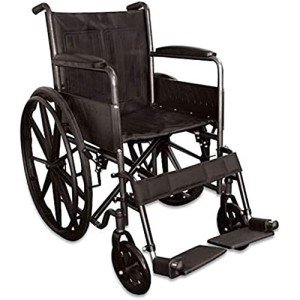The People Who Are Closest To Bariatric Wheelchair 24 Inch Seat Uncover Big Secrets

Bariatric Wheelchair Seat Width
Seat Width
Having the correct seat width is essential to wheelchair users who invest longer durations in their chairs. Too narrow a seat will trigger pressure on the hips and thighs which might cause sores or pressure points. Having too large a seat can also make it tough for the user to reach the hand rims to move themselves or maneuver in small spaces.
To determine the proper seat width a person would rest on a chair generally and have their measurement taken across their lap at the widest point which is normally their hips. A wheelchair measuring tape can be used to determine this, but a lawn stick is chosen as it prevents individuals from wrapping the tape around their hips which would give an unreliable result.
The basic wheelchair seat width is 16" (narrow adult), 18" (basic grownup), and 20" (broad grownup). For bariatric clients, a 24" seat is readily available. This durable extra wide bariatric wheelchair from Medline features swing-away footrests, a carbon steel frame with rust- and chip-resistant chrome plating, and easy-to-clean vinyl upholstery. It has a weight capacity of 500 pounds.
Seat Depth
Traditionally, the seat depth of a bariatric wheelchair was included 2" to the measurement taken at the user's largest point (typically their hips). This was meant to accommodate extra layers of clothes that may be used throughout cold weather. However, this practice is becoming less common as wheelchair users are able to spend more time inside your home and are not wearing long coats. bariatric wheelchair scale makes the seat depth of a chair lesser when choosing a bariatric wheelchair. However, it is still important to pick an alternative that uses appropriate support for larger users.
bariatric wheelchair 600 lb capacity folding additional large bariatric manual wheelchair features a comfortable 24" seat width and a sturdy slide tube silver vein frame. It also has an adjustable axle and tool-free elevating legrests.
Seat Height
When it pertains to determining the right wheelchair seat width you must always measure from the user's widest point which is generally their hips. You will also require to think about whether the user is going to be using a winter season coat as this may add 2" to the width needed.
When a wheelchair remains in usage it should just be operated on level surface areas with the wheel locks fully engaged. This is to prevent the chair from having the ability to move slopes that are 10 degrees or higher. It is also important to keep in mind that any activity that may move the center of mass in the chair need to be done with care. This consists of reaching for products that need the person to lean out of their seat or attempting to stand up from it.
Whenever you have the chair in usage it is suggested that you routinely inspect it for damage and lubricate any locations that are considered necessary. For instance, the casters must be lubricated by getting rid of the caster fork and utilizing a multi-purpose grease to use to the caster stem bearings. Also, the foot plates can be changed by loosening the bolt and after that moving them to the preferred position. This permits the feet to sit easily on the footplate and prevents any pressure points from forming. This can be extremely uneasy for the user and if left ignored, can lead to press sores.
Weight Capacity
Bariatric wheelchairs are designed to support more weight than basic wheelchairs. This makes them sturdier and better equipped to deal with falls. They are likewise generally larger and larger, making them less maneuverable in tight areas than standard wheelchairs. They need vehicles with unique ramps and lifts to fill them, in addition to motorists who understand how to finest transport them from one area to the next.

When choosing a wheelchair, consider its weight capacity as it will be the primary determining element in whether it will accommodate your traveler's needs. The weight capacity of the chair is typically listed as a fixed load, implying that it indicates the amount of weight the chair can comfortably hold while standing still. Nevertheless, some producers likewise note an active load that is based on a drop test and can replicate the impact of somebody sitting down in the chair. This may be a more trustworthy measurement of the weight limit, depending on your requirements.
If you prepare to perform activities that move your center of gravity in the seat (such as reaching for items), make certain to have front casters pointed in a forward direction and wheel locks engaged so the chair will not topple. Also, inspect that casters are lubed frequently to prevent excessive wear and abrasions. The lubrication procedure involves getting rid of the fork, separating the caster from the wheel, and greasing the caster stem bearings with top quality multi-purpose grease.
